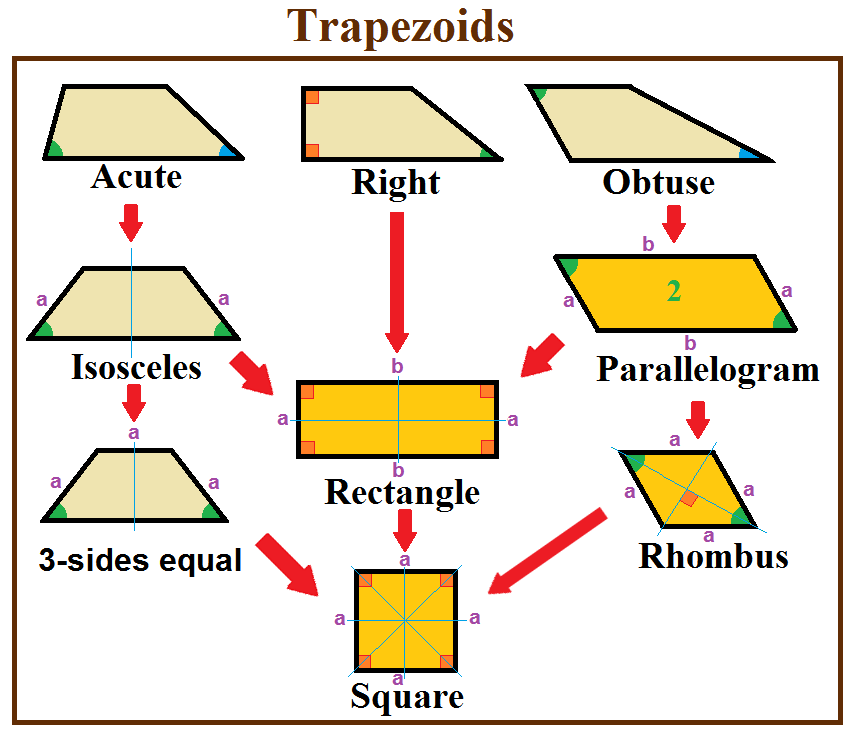|
Trapezium2
Trapezium, plural trapezia, may refer to: * Trapezium, in British and other forms of English, a trapezoid, a quadrilateral that has exactly one pair of parallel sides * Trapezium, in North American English, an irregular quadrilateral with no sides parallel * Trapezium (bone), a bone in the hand * Trapezium Cluster, a group of stars in the Orion Nebula * Trapezia (genus), ''Trapezia'' (genus), guard crabs * Trapezium (novel), ''Trapezium'' (novel), a Japanese novel by Kazumi Takayama See also *Trapezius, a muscle {{disambig ... [...More Info...] [...Related Items...] OR: [Wikipedia] [Google] [Baidu] |
Trapezoid
In geometry, a trapezoid () in North American English, or trapezium () in British English, is a quadrilateral that has at least one pair of parallel sides. The parallel sides are called the ''bases'' of the trapezoid. The other two sides are called the ''legs'' or ''lateral sides''. (If the trapezoid is a parallelogram, then the choice of bases and legs is arbitrary.) A trapezoid is usually considered to be a convex quadrilateral in Euclidean geometry, but there are also crossed cases. If ''ABCD'' is a convex trapezoid, then ''ABDC'' is a crossed trapezoid. The metric formulas in this article apply in convex trapezoids. Definitions ''Trapezoid'' can be defined exclusively or inclusively. Under an exclusive definition a trapezoid is a quadrilateral having pair of parallel sides, with the other pair of opposite sides non-parallel. Parallelograms including rhombi, rectangles, and squares are then not considered to be trapezoids. Under an inclusive definition, a trapezoid is ... [...More Info...] [...Related Items...] OR: [Wikipedia] [Google] [Baidu] |
Quadrilateral
In Euclidean geometry, geometry a quadrilateral is a four-sided polygon, having four Edge (geometry), edges (sides) and four Vertex (geometry), corners (vertices). The word is derived from the Latin words ''quadri'', a variant of four, and ''latus'', meaning "side". It is also called a tetragon, derived from Greek "tetra" meaning "four" and "gon" meaning "corner" or "angle", in analogy to other polygons (e.g. pentagon). Since "gon" means "angle", it is analogously called a quadrangle, or 4-angle. A quadrilateral with vertices A, B, C and D is sometimes denoted as \square ABCD. Quadrilaterals are either simple polygon, simple (not self-intersecting), or complex polygon, complex (self-intersecting, or crossed). Simple quadrilaterals are either convex polygon, convex or concave polygon, concave. The Internal and external angle, interior angles of a simple (and Plane (geometry), planar) quadrilateral ''ABCD'' add up to 360 Degree (angle), degrees, that is :\angle A+\angle B+\angle ... [...More Info...] [...Related Items...] OR: [Wikipedia] [Google] [Baidu] |
Trapezium (bone)
The trapezium bone (greater multangular bone) is a carpal bone in the hand. It forms the radial border of the carpal tunnel. Structure The trapezium is distinguished by a deep groove on its anterior surface. It is situated at the radial side of the carpus, between the scaphoid and the first metacarpal bone (the metacarpal bone of the thumb). It is homologous with the first distal carpal of reptiles and amphibians. Surfaces The trapezium is an irregular-shaped carpal bone found within the hand. The trapezium is found within the distal row of carpal bones, and is directly adjacent to the metacarpal bone of the thumb. On its ulnar surface are found the trapezoid and scaphoid bones. The '' superior surface'' is directed upward and medialward; medially it is smooth, and articulates with the scaphoid; laterally it is rough and continuous with the lateral surface. The '' inferior surface'' is oval, concave from side to side, convex from before backward, so as to form a saddle- ... [...More Info...] [...Related Items...] OR: [Wikipedia] [Google] [Baidu] |
Trapezium Cluster
The Trapezium or Orion Trapezium Cluster, also known by its Bayer designation of Theta1 Orionis (θ1 Orionis), is a tight open cluster of stars in the heart of the Orion Nebula, in the constellation of Orion. It was discovered by Galileo Galilei. On 4 February 1617 he sketched three of the stars ( A, C and D), but missed the surrounding nebulosity.Galileo Galilei: Siderius Nuncius, Venice, 1610. English Translation published at Bard College, Hudson, New York, October 9, 2003 English Translatio Original Latin versio/ref>Tom Pope and Jim Mosher: Galilean telescope homepage" March 17, 2006 , "Some have expressed puzzlement that in his text Galileo does not mention the nebulosity (known in modern nomenclature as M42) enveloping these stars. ... Galileo believed, as he explains in ''Sidereus Nuncius'', that what looks nebulous to the eye is resolved into stars by his telescope; what looks nebulous through his telescope could presumably also be resolved into stars by a still larger ... [...More Info...] [...Related Items...] OR: [Wikipedia] [Google] [Baidu] |
Trapezia (genus)
''Trapezia'' is a genus of guard crabs in the family Trapeziidae. Like other members of this family, they live in association with corals, feeding on coral tissue and mucus, and defending the corals from predators, like starfish. It contains the following species: *'' Trapezia areolata'' Dana, 1852 *'' Trapezia bella'' Dana, 1852 *'' Trapezia bidentata'' (Forskål, 1775) *'' Trapezia cheni'' Galil, 1983 *'' Trapezia corallina'' Gerstaecker, 1857 *'' Trapezia cymodoce'' (Herbst, 1801) *'' Trapezia digitalis'' Latreille, 1828 *'' Trapezia flavopunctata'' Eydoux & Souleyet, 1842 *'' Trapezia formosa'' Stimpson, 1869 *'' Trapezia garthi'' Galil, 1983 *'' Trapezia globosa'' Castro, 1997 *'' Trapezia guttata'' Rüppell, 1830 *'' Trapezia intermedia'' Miers, 1886 *'' Trapezia lutea'' Castro, 1997 *'' Trapezia neglecta'' Castro, 2003 *'' Trapezia punctimanus'' Odinetz, 1984 *'' Trapezia punctipes'' Castro, 1997 *'' Trapezia richtersi'' Galil & Lewinsohn, 1983 *'' Trapezia rufopunctata'' ... [...More Info...] [...Related Items...] OR: [Wikipedia] [Google] [Baidu] |



